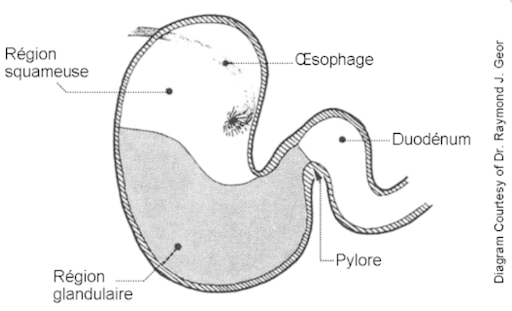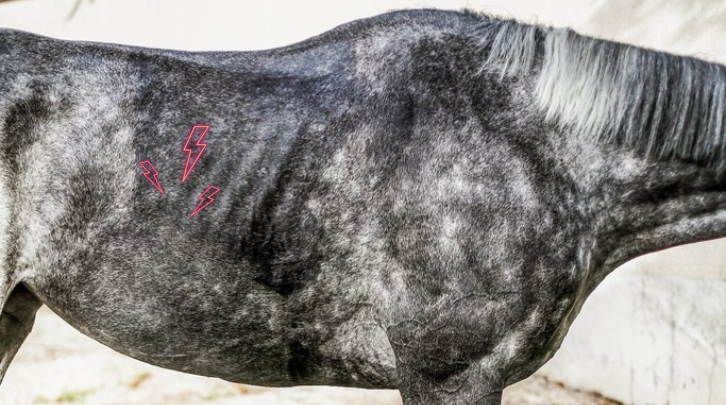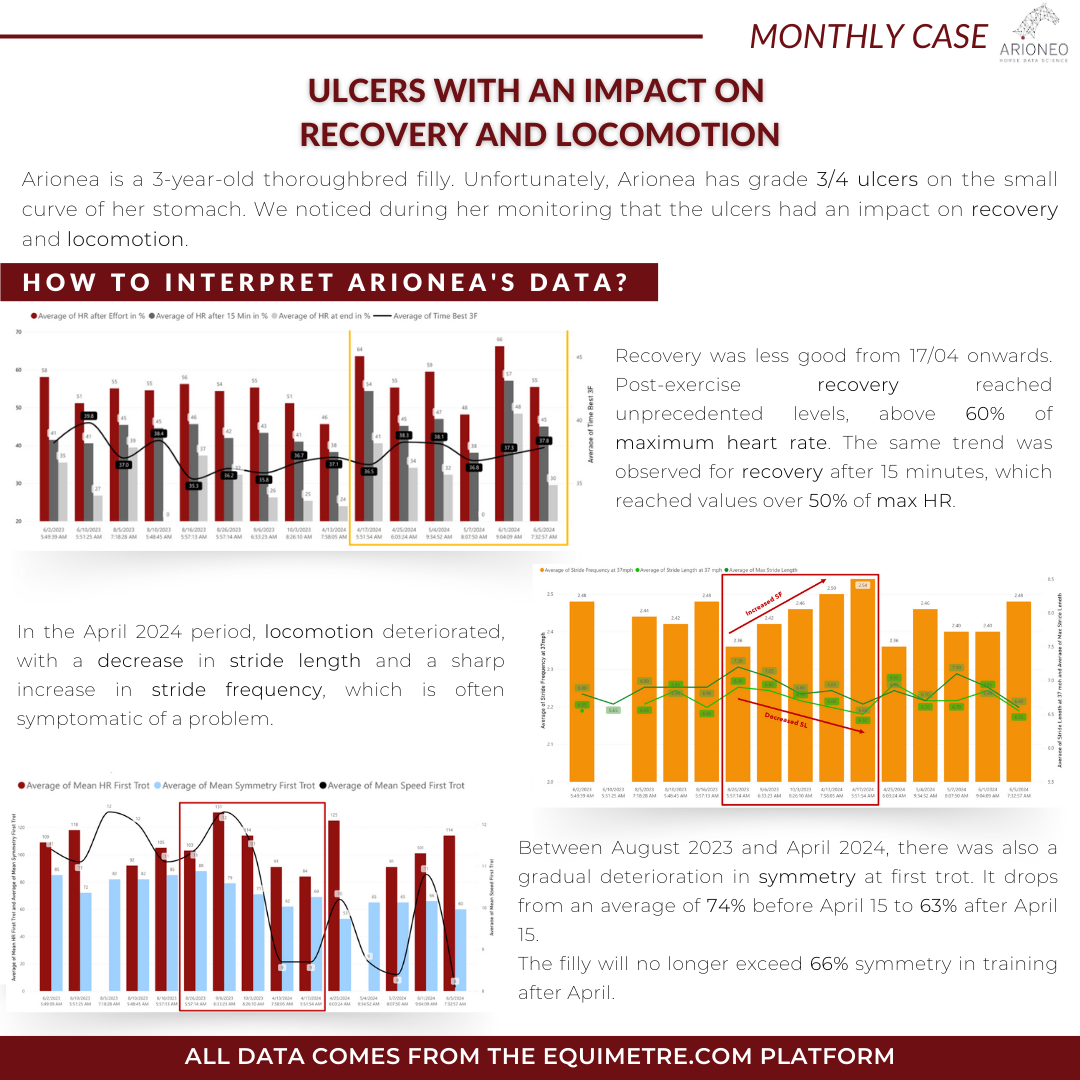Gastric ulcers are erosive gastric mucosa lesions caused by hydrochloric acid and mucus production imbalance. This pathology is very common in horses, both adults and foals. But it happens particularly in horses with high levels of physical activity, such as racehorses or sport horses.
Gastric ulcers are the most common gastric pathology in horses and can develop for a variety of reasons, depending on which part of the stomach is affected.
The different forms of ulcers and their symptoms
The horse’s stomach consists of two distinct parts: the squamous region and the glandular region. On the one hand, the squamous region is located in the dorsal part of the stomach and is the least important. On the other hand, the glandular region occupies two-thirds of the stomach and consists of mucus-secreting cells and gastric glands. In horses, ulcers can develop in any of these areas of the stomach in various forms.

Squamous lesions
Squamous lesions are most likely to develop in adult horses with a high level of physical activity. Indeed, during exercise, the abdominal muscles contract, increasing intra-abdominal pressure. This pressure will generate a significant secretion of gastric acids, which will damage the mucosa. It is this high-intensity pressure, applied over a long and repetitive time, that creates ulcers in cases of intense physical effort. These ulcers are therefore the most common in racehorses.
Glandular lesions
Glandular lesions are caused by a disturbance in the balance between gastric acidity and the protective barriers of the mucosa. Indeed, the mucosa is protected from acids by two barriers. Firstly, a physical barrier is made up of rapidly renewing cells. And secondly, a chemical barrier, which is mainly the mucus secreted by the mucosa. Glandular ulcers will therefore develop when the balance between these barriers and the gastric acid is lost. However, the precise cause of this imbalance remains difficult to determine.
Symptoms
Gastric ulcers can be relieved by various factors, mainly behavioral. Horses suffering from ulcers will be subjected to discomfort caused by the pain of the lesion. This will be accentuated at work by intra-abdominal pressure.
The horse may develop different behaviors during meals. Among the symptoms of gastric pain, we can notice yawning, reduced appetite, colic symptoms after meals, or even tooth grinding (bruxism). In terms of general health, a horse may suffer from ulcers due to factors such as severe fatigue, weight loss, poor coat condition, or soft dung.
It’s important to take all these behavioral changes into account to prevent ulcers from developing too much. Because, if they are not treated quickly enough, they can develop and worsen. In some cases, ulcers develop into perforating ulcers, deep lesions that can reach the blood vessels. This type of ulcer can be identified by observing the dung. Melena, black or brown digested blood, can be found in the droppings.
Impact on the performance
Ulcers can be a real brake on a racehorse’s sporting performance, affecting its diet, behavior, and general physical condition. It can therefore impair its performance.
Racehorses are particularly vulnerable to gastric ulcers, with studies showing that 50-90% (according to IFCE) of equines may suffer from them at some point in their career. This high prevalence is due to several factors linked to their lifestyle and training regime. Body stress linked to muscular effort is one of the main factors. Indeed, racehorses are subjected to rigorous training regimes, frequent competitions, and constant travel, all of which generate stress. This stress increases gastric acid production, which can damage the stomach lining and lead to ulcer formation.
Poor horse nutrition in the event of ulcers is the cause of many of the factors linked to loss of performance in racehorses. Ulcers cause a significant reduction in the horse’s diet and appetite. This lack of nutrition can lead to weight loss and reduced muscle mass, which in turn can diminish the horse’s ability to perform. The malnutrition caused by the pain of ulcers can also have an impact on stamina. They may have reduced stamina and less ability to maintain high performance over long distances. These are important factors that can affect a horse’s performance.
Case study of ulcers impacting recovery and locomotion
How to prevent ulcers and treat them ?
How to prevent it?
In their natural environment, horses spend an average of 10 hours a day feeding, allowing their stomachs to function continuously. Even in the absence of food, the horse is constantly producing saliva and gastric acid. Horses are often fed two or three meals a day, with varying access to forage. Although this routine is common and suitable for many horses, it can sometimes lead to prolonged periods of fasting. These periods without food, while manageable for most horses, can nevertheless increase the risk of developing ulcers in more sensitive individuals. It is therefore important to adjust the diet to the specific needs of each horse to minimize this risk.
The horse’s stomach will continually secrete gastric acid, even when no food is present. Fasting will cause the horse’s gastric pH to drop, resulting in prolonged exposure of the squamous mucosa to acid. To control this, it’s a good idea to give the horse as much hay as he wants so that he eats 7 to 8 kg a day. This forage will provide the horse with fiber and neutralize acid production, thanks to the buffering effect of saliva on gastric acid. Feeding forage before labor is also a good pre-training feeding method. This will enable twice as much saliva to be produced, providing an effective buffer against acidity and protecting the squamous mucosa.
The cereal starch content of the horse’s diet is another point to watch. Meals made up of concentrated feeds given to athletic horses are bulkier, fill the stomach more, and are richer in starch. As a result, the feed will facilitate the development of bacterial fermentation and remain in the stomach longer. This fermentation facilitates the development of volatile fatty acids (VFAs) and slows gastric emptying. In an acidic environment, VFAs can infiltrate the cells of the mucosa. As a result, the squamous mucosa is more likely to be exposed to the acidic and corrosive contents, and thus to the development of squamous ulcers. That’s why it’s so important to pay meticulous attention to the horse’s diet and feeding methods.
Treatment of ulcers
When in doubt, the best way to detect an ulcer is gastric endoscopy. This painless procedure enables detection of the exact position of the ulcer and its severity. Thus, treatment can be adapted as best as possible by passing a camera through the horse’s nostrils. Endoscopy can also be an effective means of monitoring the evolution of the ulcer, with follow-up endoscopies to ensure that treatment is effective.
Various ulcer treatments are available to eliminate clinical effects and facilitate healing. The main aim of these treatments is to reduce the acidity of the horse’s stomach, so that the stomach walls are less attacked and healing is optimized. For that, the most commonly used molecule is omeprazole, administered by syringe into the mouth. In addition to omeprazole, a gastric dressing can be applied in the form of a liquid gel or tablet. This will, on contact with the stomach, form a gel to cover the ulcer while it heals.
Ulcers can be detected through regular data collection. Inconsistencies in recovery or locomotion data can be warning signs. Following treatment, it is important to continue monitoring the horse to check that its data is returning to normal. In particular, it is important to ensure that heart rate readings during warm-up return to the horse’s normal values. An abnormally high heart rate in the first trot can be a sign of pain.
We also check that cardio parameters such as recovery after exercise and recovery after 15 minutes have returned to normal. If the ulcers have been accompanied by changes in the horse’s locomotion, it will be interesting to analyze the data on symmetry at first trot and amplitude (at 50 or 60 km/h for example) so that these gradually return to normal.
Conclusion
Gastric ulcers, although common in horses, represent a major challenge for trainers and owners, especially in racing stables. This pathology, if not properly monitored and treated, can not only affect the well-being of horses but also compromise their long-term performance.
The use of data is proving to be a valuable tool in the management of ulcers. Not only can early signs of the disease be detected, but their severity can also be quantified, their onset dated, and the effectiveness of treatment monitored until the condition returns to normal. Thanks to these analyses, trainers can better anticipate their horses’ needs and proactively adjust their management.
It is therefore essential to adopt a preventive approach to care, including rigorous management of the diet and stress factors specific to athletic horses. If ulcers are suspected, rapid endoscopic diagnosis and accurate follow-up based on reliable data can help mitigate the effects of this pathology and prevent recurrence.
Ultimately, horses’ gastric health must remain a priority throughout their sporting career. By combining constant vigilance, the use of data for fine analysis, and personalized adjustments, we can not only preserve their well-being but also maximize their performance on the track.
Key words : Arioneo, ulcers, gastric, horses, racing, food, prevention, wellness, sport, athlete, trainer, horse


